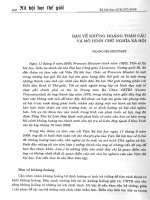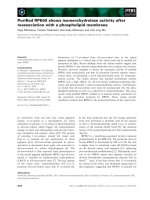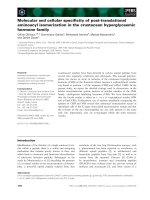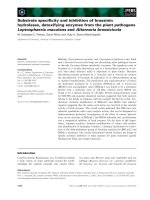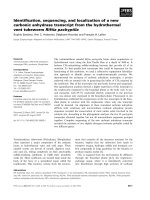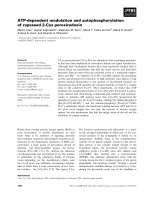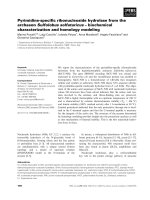Báo cáo khoa học: Catalytically active membrane-distal phosphatase domain of receptor protein-tyrosine phosphatase a is required for Src activation doc
Bạn đang xem bản rút gọn của tài liệu. Xem và tải ngay bản đầy đủ của tài liệu tại đây (354.63 KB, 9 trang )
Catalytically active membrane-distal phosphatase domain
of receptor protein-tyrosine phosphatase a is required for
Src activation
Andrei M. Vacaru
1
and Jeroen den Hertog
1,2
1 Hubrecht Institute – KNAW and University Medical Center, Utrecht, the Netherlands
2 Institute of Biology Leiden, Leiden University, the Netherlands
Introduction
Receptor protein-tyrosine phosphatases (RPTPs), like
their cytoplasmic relatives, counteract the activity of
tyrosine kinases by dephosphorylating phosphotyrosine
residues. Based on the structure of their extracellular
domain, the RPTPs are classified into eight subtypes
[1–3]. The ectodomains may play an important role in
the regulation of the RPTPs following cell–cell or cell–
matrix contacts, or upon interaction with specific extra-
cellular ligands [4,5]. Besides the extracellular domain,
the majority of the RPTPs present another interesting
feature: tandem catalytic domains. The membrane-
proximal catalytic domain (D1) and the membrane-
distal phosphatase domain (D2) of RPTPs are highly
conserved, in that the D2 domains contain a protein-
tyrosine phosphatase (PTP) signature motif, similarly
to the D1 domains [6]. In addition, the 3D structures
are conserved between D1 and D2 domains [7–9]. How-
ever, most RPTP-D2 domains have very low or no cata-
lytic activity [10–12]. In the case of LAR and RPTPa
the absence of two residues in the D2 domain– the
Keywords
kinase activity; protein-tyrosine
phosphatase; receptor protein-tyrosine
phosphatase a (RPTPa); regulation; Src
Correspondence
J. den Hertog, Uppsalalaan 8, 3584 CT
Utrecht, the Netherlands
Fax: +31 30 2516464
Tel: +31 30 2121800
E-mail:
(Received 16 October 2009, revised
30 December 2009, accepted 18 January
2010)
doi:10.1111/j.1742-4658.2010.07584.x
Receptor protein-tyrosine phosphatase a (RPTPa) is a transmembrane pro-
tein with tandem cytoplasmic phosphatase domains. Most of the catalytic
activity is contained by the membrane-proximal catalytic domain (D1). We
found a spontaneous Arg554 to His mutation in the pTyr recognition loop
of the membrane-distal phosphatase domain (D2) of a human patient. This
mutation was not linked to the disease. Here, we report that the R554H
mutation abolished RPTPa-D2 catalytic activity. The R554H mutation
impaired Src binding to RPTPa. RPTPa, with a catalytic site cysteine to
serine mutation in D2, also displayed diminished binding to Src. Concomi-
tant with decreased Src binding of the R554H and C723S mutants com-
pared with wild-type RPTPa, enhanced phosphorylation of the inhibitory
Src Tyr527 site was observed, as well as reduced Src activation. To confirm
that catalytic activity of RPTPa-D2 was required for these effects, we ana-
lyzed a third mutant, RPTPa-R729K, which had an inactive D2. Again,
Src binding was reduced and Tyr527 phosphorylation was enhanced. Our
results suggest that a catalytically active D2 is required for RPTPa to bind
and dephosphorylate its well-characterized substrate, Src.
Structured digital abstract
l
MINT-7551862, MINT-7552454, MINT-7552515: Src (uniprotkb:P12931) physically interacts
(
MI:0915) with RPTP alpha (uniprotkb:P18052)byanti bait coimmunoprecipitation
(
MI:0006)
Abbreviations
D1, membrane-proximal catalytic domain; D2, membrane-distal phosphatase domain; GST, glutathione S-transferase; HA, hemagglutinin;
LAR, leukocyte common antigen related; pNPP, para-nitrophenylphosphate; PTP, protein-tyrosine phosphatase; RPTP, receptor protein-
tyrosine phosphatase; TCR, T-cell receptor.
1562 FEBS Journal 277 (2010) 1562–1570 ª 2010 The Authors Journal compilation ª 2010 FEBS
tyrosine from the pTyr recognition loop (also known
as the KNRY motif) and the aspartic acid from the
WPD loop – was shown to be responsible for
decreased catalytic activity. Upon substitution of these
two residues, the catalytic activity of the D2 domains
was greatly increased [7,13,14]. RPTPe-D2, but not
CD45-D2, regained catalytic activity upon changing
the two amino acids mentioned above [15].
The biological function of these membrane-distal
domains is not completely understood. Soon after they
were discovered, the RPTP-D2s were suggested to alter
the substrate specificity of D1 in vitro [10,11]. In addi-
tion, the D2 domains were shown to be involved in
intermolecular and intramolecular interactions, as well
as in homodimerization and oligomerization of RPTPs
[9,16–21]. Based on the crystal structures of LAR and
CD45, another role of the D2 domain was proposed:
stabilization of the D1 domain [7,22]. These interactions
suggest that the D2 domains function as regulators of
the activity of the D1 domains. LAR-D2 was shown to
be important for the interaction with downstream effec-
tors, including Trio [23], Abl kinase and Enabled [24],
b-catenin [25] and Liprin-a [26]. Another study indi-
cated that an acidic region from CD45-D2 is required
for the regulation of TCR-mediated calcium-signaling
pathways [27]. The involvement of D2 domains in sub-
strate recognition was observed for CD45-D2, which
seems to mediate the interaction with Lck [28].
The D2 domain of RPTPa is the only known mem-
brane-distal domain with considerable catalytic activity
[10,14,29]. It was shown that its activity is comparable
to, or even higher than, the activity towards para-nitro-
phenylphosphate (pNPP) of dual-specificity phosphata-
ses such as cdc25, VH1 and YPTP1 [14]. One of the main
roles identified to date for RPTPa-D2 is that of a redox
sensor. This function is dependent on its catalytic cyste-
ine (Cys723). Following hydrogen peroxide-induced oxi-
dation, this cysteine mediates the stabilization of RPTPa
dimers followed by complete inactivation of the enzyme
and rotational coupling of the extracellular domain
[30,31]. RPTPa-D2 is essential for RPTPa homodimer-
ization in the absence of oxidizing reagents [32] and has
a role in pervanadate-induced tyrosine phosphorylation
of RPTPa [33], showing that D2 is involved in protein–
protein interactions. Besides the interaction with other
phosphatase domains, RPTPa-D2 binds to calmodulin,
leading to the inactivation of the D2 domain [34].
We discovered an R554H mutation in the KNRY
motif of RPTPa-D2 in a screen for disease-related muta-
tions in RPTPs. Whereas this mutation appears not to
be linked to disease, we observed that this mutation in
the pTyr recognition loop of RPTPa-D2 completely
abolished catalytic activity. Furthermore, we observed
decreased binding of Src, a well-known RPTPa sub-
strate, to RPTPa-R554H and to RPTPa-C723S, another
mutant with an inactive D2 domain. Src Tyr527 dephos-
phorylation and activation was also reduced in response
to these mutations, compared with wild-type RPTPa.
A third mutant, RPTPa-R729K, with impaired catalytic
activity in the D2 domain, confirmed that a catalytically
active D2 domain appears to be required for Src binding
and Tyr527 dephosphorylation.
Results
Identification of a naturally occurring mutation in
RPTPa
We hypothesized that mutations in RPTPa might be
linked to Noonan syndrome, a dominantly inherited
human syndrome. Several genes have been identified
that are associated with Noonan syndrome, most
prominently PTPN11, encoding the cytoplasmic PTP,
Shp2. Approximately 50% of all patients with Noonan
syndrome contain dominant activating mutations in
PTPN11 [35]. Other genes that are associated with
Noonan syndrome encode factors in the Ras–mitogen-
activated protein kinase (MAPK) pathway: SOS1,
KRAS, BRAF and RAF1 [36–39]. To assess whether
RPTPa is also involved in Noonan syndrome, we
sequenced all 22 exons of PTPRA in a panel of 46
patients with Noonan syndrome who did not contain
mutations in genes that are known to be associated
with Noonan syndrome. We identified a heterozygous
point mutation in exon 16 in a single patient, resulting
in a missense mutation, R554H, in the absolutely con-
served Arg residue of the KNRY motif or pTyr loop
of RPTPa-D2. Subsequently, PTPRA was sequenced
in the unaffected parents of this de novo patient and it
was found that the mother carried the same mutation,
making a causal role for the R554H mutation in
RPTPa in Noonan syndrome unlikely. Subsequently, a
mutation was identified in SOS1, resulting in the mis-
sense mutation T266K in the Sos1 protein. This muta-
tion has also been identified in other Noonan patients
and we therefore concluded that Noonan syndrome in
this patient was probably caused by the missense
mutation in SOS1 , not by a mutation in PTPRA.
Nevertheless, biochemically, RPTPa–R554H behaved
differently from wild-type RPTPa.
R554H mutation abolished catalytic activity of
RPTPa-D2
RPTPa Arg554 is an absolutely conserved residue in
the pTyr recognition loop (the KNRY motif). This
A. M. Vacaru and J. den Hertog Active RPTPa-D2 is required for Src activation
FEBS Journal 277 (2010) 1562–1570 ª 2010 The Authors Journal compilation ª 2010 FEBS 1563
Arg residue is important for electrostatic attraction of
ligands and is a putative substrate-binding site [6]. We
tested whether the R554H mutation had an influence
on the catalytic activity of RPTPa-D2 in vitro by using
glutathione S-transferase (GST)-fusion proteins and
pNPP as a substrate. The phosphatase activity of
D2-R554H was compared with that of wild-type
(WT)-D2 and with that of D2-C723S, a catalytically
dead mutant with a mutation in the essential catalytic
site cysteine. The catalytic activity of D2-R554H was
dramatically reduced compared with that of WT-D2
and only slightly higher than the activity of D2-C723S,
the inactive mutant (Fig. 1). These results show that
the Arg554 residue is essential for the catalytic activity
of RPTPa-D2.
Catalytic activity of the RPTPa D2 domain is
required for Src binding and activation
It is well known that the membrane distal domains of
RPTPs are involved in protein–protein interactions
[16–18,20,28]. We investigated whether the introduc-
tion of inactivating mutations in RPTPa-D2 (R554H
and C723S) affected the interaction with Src, the well-
established substrate of RPTPa. For this purpose,
SYF cells that lack endogenous Src, Fyn and Yes were
transiently cotransfected with constructs encoding Src
and hemagglutinin (HA)-tagged RPTPa WT, RPTPa-
R554H or RPTPa-C723S. Src was immunoprecipitated
from the SYF lysates and the samples were probed for
co-immunoprecipitated (mutant) RPTPa. HA-RPTPa-
R554H binding to Src was substantially reduced (by
approximately 50%) when compared with the binding
of WT RPTPa to Src (Fig. 2A). The interaction of Src
with the RPTPa-C723S mutant was decreased to a
similar extent. The interaction between RPTPa and
Src may be mediated by pTyr789. Therefore, we tested
whether the phosphorylation of Tyr789 was affected in
R554H and C723S mutants and no significant differ-
ences in the pTyr789 levels were observed. Tyr789
phosphorylation of endogenous RPTPa was not
detected (Fig. 2A, bottom panel, lane 2), because
expression of endogenous RPTPa is relatively low in
SYF cells and only approximately 10% of the cells are
transfected with Src, which induces phosphorylation of
RPTPa Tyr789. These results indicate a role for
RPTPa-D2 in the interaction with Src, which is sepa-
rate from the phosphorylation of Tyr789.
Next, we analyzed the ability of RPTPa and
mutants to activate Src. Fractions of the same lysates
used for Src immunoprecipitation were tested for Src
Tyr416 and Tyr527 phosphorylation, indicators of Src
activation. When cotransfected with wild-type RPTPa,
phosphorylation of the inhibitory pTyr527 was
reduced (Fig. 2B; see also Fig. 4B, cf. lanes 2 and 3).
The effects of cotransfection of mutant RPTPa-R554H
on Src phosphorylation were less pronounced than of
wild-type RPTPa. Src pTyr527 dephosphorylation in
RPTPa-R554H transfected cells was approximately
65% of pTyr527 dephosphorylation in wild-type
RPTPa cotransfected cells. Cotransfection of RPTPa-
C723S with Src also led to a significant decrease in Src
pTyr527 (approximately 46% of wild-type RPTPa).
Src Tyr416 autophosphorylation was reduced in
R554H and C723S transfected cells, to 83% and 59%,
respectively, compared with wild-type cotransfected
cells (Fig. 2B). These results suggest that RPTPa-medi-
ated Src dephosphorylation was impaired in RPTPa
mutants with inactive D2 domains.
To establish the ability of RPTPa-D2 mutants to
activate Src, we tested the in vitro
kinase activity of
Src immunoprecipitated from SYF cells cotransfected
with Src and RPTPa WT, R554H or C723S. The
activity of Src in the presence of RPTPa R554H was
clearly reduced compared with the activity of Src
cotransfected with WT RPTPa. RPTPa-C723S acti-
vated Src only minimally under these experimental
conditions (Fig. 3A). Three independent experiments
Fig. 1. The R554H mutation abolished
RPTPa-D2 catalytic activity. The catalytic
activity of GST-fusion proteins containing
the D2 domain of RPTPa WT, R554H or
C723S was tested in vitro using pNPP as
the substrate. The error bars represent
± SD of three independent phosphatase
activity determinations. Equal amounts of
protein were used in the PTP experiment,
as indicated in the inset, showing
Coomassie Brilliant Blue-stained fusion
proteins on an SDS-polyacrylamide gel.
Active RPTPa-D2 is required for Src activation A. M. Vacaru and J. den Hertog
1564 FEBS Journal 277 (2010) 1562–1570 ª 2010 The Authors Journal compilation ª 2010 FEBS
were quantified and the results indicated that WT
RPTPa activated Src 2.2-fold. RPTPa-R554H acti-
vated Src 1.7-fold and RPTPa-C723S did not activate
Src significantly (1.1-fold) (Fig. 3B). These results indi-
cate that the catalytic activity of RPTPa-D2 plays an
important role in Src activation.
To confirm that the catalytic activity of RPTPa-D2 is
required for Src binding and activation, we used an
RPTPa-D2 mutant (RPTPa-R729K) with an Arg to
Lys mutation in the PTPase signature motif in the D2
domain. This Arg residue has an essential role in cata-
lysis in PTPs, and mutation of this residue in PTPs
results in the inactivation of catalytic activity, but does
not result in substrate-trapping mutants. Likewise,
mutant RPTPa-D2-R729K has no catalytic activity in
the D2 domain [33]. Src was co-expressed in SYF cells
with RPTPa-R729K and Src was immunoprecipitated.
The RPTPa-R729K mutant showed a reduction in Src
binding of approximately 75% compared with RPTPa
WT (Fig. 4A). In the presence of RPTPa-R729K, Src
pTyr527 dephosphorylation was strongly decreased to
20% of the wild-type RPTPa cotransfected response,
and Tyr416 was only mildly affected (Fig. 4B), sugges-
ting that RPTPa-R729K is not able to dephosphorylate
Src pTyr527 and activate Src. Taken together, these
results indicate that catalytically active RPTPa-D2 is
required for binding and activation of Src.
Discussion
Here we report that inactivating mutations in the
membrane-distal domain of RPTPa affected the bio-
logical function of RPTPa, impairing Src binding and
its ability to activate Src. Our results indicate that a
catalytically active D2 domain is required for RPTP a-
mediated Src binding and activation.
We identified a heterozygous mutation in RPTPa in
a patient with de novo Noonan syndrome and we
found the same heterozygous mutation in one of the
unaffected parents, indicating that this mutation was
not causally linked to Noonan syndrome. We demon-
strate here that RPTPa-R554H was functionally
impaired. Apparently, a single wild-type allele of
RPTPa is sufficient for human life and the R554H
Src WT
+ + +
IP: Src
IB: RPTPα
α
%
100 65 46
WCLs
IB: npY527
Src WT
–+
– + + + + +
10092
IP: Src
IB: Src
%
100 45n.d. n.d. 55
WCLs
IB: Src
WCLs
IB: pY416
%
100 83 59100192
WCLs
IB: HA
WCLs
IB: pY789
A
B
Fig. 2. Src association with RPTPa-R554H and RPTPa-C723S mutants is reduced. (A) SYF cells were cotransfected with Src and HA-RPTPa
WT, R554H or C723S, lysed and Src was immunoprecipitated with cross-linked Src mAbs. The samples were fractionated on a 7.5% SDS-
polyacrylamide gel, transferred to poly(vinylidene difluoride) (PVDF) membranes and immunoblotted with anti-RPTPa serum and with the Src
mAb 327. Whole-cell lysates were probed with the HA mAb 12CA5 to monitor HA-RPTPa expression and with anti-pY789 to assess Tyr789
phosphorylation. The amount of co-immunoprecipitated RPTPa was quantified and normalized for total pTyr789 levels. The samples with no
transfected RPTPa were not determined (n.d.). (B) A fraction of the lysates used for Src immunoprecipitation was boiled in SDS sample
buffer and the samples were run on a 7.5% SDS-polyacrylamide gel. The proteins were transferred to PVDF membranes, which were then
probed with anti-npY527 Ig and subsequently, after stripping, with anti-pY416 and anti-Src Igs, as indicated. Src phosphorylation was quanti-
fied and the values were normalized for the total amounts of Src. The quantification results are presented under the corresponding panels.
This experiment was carried out three times and the results of one representative experiment are depicted here.
A. M. Vacaru and J. den Hertog Active RPTPa-D2 is required for Src activation
FEBS Journal 277 (2010) 1562–1570 ª 2010 The Authors Journal compilation ª 2010 FEBS 1565
mutation does not have a dominant effect over the
wild-type RPTPa allele. It is noteworthy that heterozy-
gous RPTPa knockout mice are indistinguishable from
wild-type siblings [40,41], corroborating the conclusion
that a single RPTPa allele is sufficient for mammalian
life.
Mutant RPTPa-D2-R554H was almost completely
inactive compared with WT RPTPa-D2. Arg554 is
located in the pTyr recognition loop (the so-called
KNRY motif) next to Val555, one of the amino acids
responsible for decreased catalytic activity of RPTPa-
D2 [13]. The conserved arginine residue was proposed
to be involved in the electrostatic attraction of the sub-
strate [6], and mutation of the corresponding arginine
(Arg45) to Ala in PTP1B led to very low catalytic
activity, probably as a result of structural perturbation
of the catalytic site [42]. As seen from the crystal struc-
ture of RPTPa-D2 [8], Arg554 is positioned very close
to Cys723, and mutation of this amino acid could
indeed disturb the architecture of the catalytic site.
The in vitro catalytic activity of the entire cytoplasmic
domain of RPTPa was not significantly affected by the
R554H mutation (data not shown) but this is not
unexpected because the D2 domain only marginally
contributes to the overall catalytic activity of RPTPa
[10,14,29].
Src binding to three different RPTPa-D2 inactive
mutants was impaired. Moreover, the ability of these
mutants to activate Src was reduced when compared
with WT RPTPa. According to the current model, Src
binds to phosphorylated Tyr789 of RPTPa via its SH2
Src WT
IP: Src
IB: RPTPα
%
100 25n.d. n.d.
100 20
Src WT
WCLs
IB: npY527
%
WCLs
IP: Src
IB: Src
%
WCLs
IB: Src
WCLs
IB: pY416
%
–+++
–+++
100 91
n.d n.d
n.d. n.d.
IB: HA
WCLs
IB: pY789
A
B
Fig. 4. Impaired Src binding to the inert RPTPa-R729K mutant. (A)
SYF cells cotransfected with Src and empty vector, HA-RPTPa WT
or HA-RPTPa-R729K were lysed and Src was immunoprecipitated.
The samples obtained were run on 7.5% SDS-polyacrylamide gels,
transferred to poly(vinylidene difluoride) (PVDF) membranes and
probed for co-immunoprecipitated RPTPa and total Src. Lysates
were probed for the amount of RPTPa and for pTyr789. (B) A frac-
tion of the cell lysates used for Src immunoprecipitation was pro-
cessed and tested for Src pTyr416 and npTyr527. Quantification of
the blots was performed as described in Fig. 2. This experiment
was carried out three times and a representative result is depicted
here.
Src – + + + +
Autoradiograph
IP: anti-Src
IB: anti-Src
WCLs
IB: anti-HA
Src
enolase
A
B
2.5
1.5
Relative Src kinase activity
1
0.5
0
vect. WT
R554H
C723S
2
Fig. 3. Reduced activation of Src by RPTPa-R554H and RPTPa-
C723S. (A) Src was immunoprecipitated from SYF cells cotransfect-
ed with Src and RPTPa constructs. Half of the immunoprecipitate
was subjected to an in vitro kinase assay, using enolase as a sub-
strate, and the amount of incorporated phosphate was visualized
by autoradiography (top panel). The positions of enolase and Src
are indicated. The other half of the immunoprecipitate was fraction-
ated by electrophoresis on a 7.5% SDS-polyacrylamide gel, blotted,
probed with anti-Src Ig and developed with enhanced chemilumi-
nescence (ECL) (middle panel). Part of the lysate was resolved on
a 7.5% SDS-polyacrylamide gel, transferred to poly(vinylidene diflu-
oride) (PVDF) membrane and probed for total RPTPa expression
(bottom panel). (B) Relative Src kinase activity. Each bar represents
the average of three independent experiments ± SD, relative to
Src immunoprecipitated from cells cotransfected with the empty
vector, which was set to one.
Active RPTPa-D2 is required for Src activation A. M. Vacaru and J. den Hertog
1566 FEBS Journal 277 (2010) 1562–1570 ª 2010 The Authors Journal compilation ª 2010 FEBS
domain [43]. We did not observe significant changes in
Tyr789 phosphorylation of the D2 domain-inactive
mutants compared with WT RPTPa (Figs 2A and 4A)
that would account for reduced Src binding to these
RPTPa mutants. In contrast to the current model, we
have evidence that Tyr789 is not required for Src bind-
ing, in that mutation of Tyr789 in RPTPa did not
abolish Src binding to RPTPa (AV, JdH, submitted),
suggesting the presence of other Src-binding sites in
RPTPa. Taken together, phosphorylation of Tyr789 is
not the only determinant in Src binding. Instead, we
provide evidence that other features of RPTPa-D2
mediate Src binding. In addition, we cannot exclude
the possibility that the Src-binding site is not located
in RPTPa-D2.
Functional analysis of the tandem PTP domains of
RPTPa indicated that mutation of the catalytic Cys723
did not affect phosphorylation of the Src family kinase
Fyn, or Fyn autophosphorylation activity [44]. The
apparent difference with our results may be caused by
differences in experimental conditions: they assessed
total Fyn phosphorylation, whereas we detected phos-
phorylation on two specific sites in Src; they deter-
mined Fyn autophosphorylation, whereas we assessed
Src kinase activity by measuring the in vitro phosphoryl-
ation of an exogenous substrate. Alternatively, the
apparent difference may reflect the fact that the effects
we observed are specific for Src.
Ever since their discovery, it has been speculated
that RPTP D2 domains may have a role in substrate
binding and substrate presentation to the catalytically
active D1 domain [45]. This hypothesis was con-
firmed in a study showing that the catalytic site of
LAR-D2 is required for binding to the insulin recep-
tor, a known LAR substrate [46]. The interaction is
decreased when the catalytic cysteine in LAR-D2 is
mutated to serine. Another example is CD45 binding
to the Src family kinase Lck, which is mediated by
a unique acidic region in CD45-D2 [28]. CD45-D2 is
also critical for substrate recruitment of TCR-zeta
in vivo, because replacement of the membrane-distal
domain of CD45 with the LAR D2 domain abo-
lishes the binding of TCR-zeta [47].
It remains to be determined definitively how the
three mutants that we analyzed affect Src binding and
activation. It is unlikely that these mutations disrupt
the structure of RPTPa-D2, because the mutations are
subtle. Moreover, Cys to Ser mutations of other PTPs
showed the expected crystal structures. In conclusion,
we demonstrate here, for the first time, that a func-
tional, catalytically active D2 is required for RPTPa to
bind to its substrate, Src, and to dephosphorylate and
activate it.
Materials and methods
Materials and antibodies
Anti-HA-tag (12CA5), anti-Src (327) Igs and anti-RPTPa
(5478AP) serum were prepared as previously described
[48,49]. Anti-Src-npY527 was from Cell Signaling and anti-
Src-pY418 was from Biosource. Horseradish peroxidase-
coupled anti-rabbit and anti-mouse secondary Igs were
from BD Biosciences. Polyethylenimine, nocodazole, paclit-
axel, glutathione–Sepharose and hydrogen peroxide were
from Sigma Life Science. FuGene6 transfection reagent was
from Roche.
DNA constructs
The constructs used for the expression of HA-RPTPa WT
[48], Src WT [49] and HA-RPTPa R729K [33] were as pre-
viously described. HA-RPTPa R554H was obtained by site-
directed mutagenesis using HA-RPTPa WT as the template
and the following forward and reverse oligonucleotides:
5¢- ATG AAG AAG AAC CAT GTT TTA CAG ATC -3¢
and 5¢ - GAT CTG TAA AAC ATG GTT CTT CTT
CAT-3¢. The constructs encoding WT, R554H or C723S
GST-PTPalpha D2 fusion proteins were obtained by direc-
tional cloning of PCR fragments digested with NcoI and
HindIII into the pGEX-KG vector digested with the same
restriction enzymes. The PCR fragments were obtained by
amplification with 5¢ - CCC ATG GCT TCT CTA GAA
ACC-3¢ and 5¢ - CGC AAG CTT TCA CTT GAA GTT
GGC - 3¢ oligonucleotides using pSG RPTPa WT, pSG
RPTPa R554H or pSG RPTPa C723S as templates. The
constructs were verified by sequencing.
Cell culture and transfection
For the experiments described in this study we used SYF
cells. SYF cells were grown in Dulbecco’s modified Eagle’s
medium (DMEM) supplemented with 7.5% fetal bovine
serum. The cells were transfected with FuGene6 according
to the protocol provided by the manufacturer. After trans-
fection the cells were grown for 16 h in complete medium,
then the medium was replaced with serum-free medium and
the cells were grown for an additional 24 h.
Recombinant proteins
The constructs encoding GST-fusion proteins were trans-
formed into BL21 bacteria. Expression of fusion proteins
was induced by incubation with 0.1 mm isopropyl thio-b-d-
galactoside (IPTG) for 5 h at 25 °C. The bacteria were har-
vested by centrifugation, resuspended in NaCl ⁄ Tris solution
containing 1 lgÆmL of leupeptin, 1 lgÆmL
)1
of aprotinin
and 1 mgÆmL
)1
of lysozyme, and incubated for 10 min at
room temperature. The suspension was sonicated on ice,
A. M. Vacaru and J. den Hertog Active RPTPa-D2 is required for Src activation
FEBS Journal 277 (2010) 1562–1570 ª 2010 The Authors Journal compilation ª 2010 FEBS 1567
supplemented with 1% Triton X-100, kept for 10 min on
ice and centrifuged to collect the soluble proteins. The su-
pernatants were mixed with glutathione agarose to pull-
down the GST-fusion proteins, and incubated for 30 min at
4 °C. The beads were washed three times with ice-cold
NaCl/Tris. The GST-fusion proteins were eluted twice for
5 min at room temperature with elution buffer containing
50 mm Tris ⁄ HCl, pH 8.0, 10 mm reduced glutathione and
10% glycerol. The proteins were dialyzed against NaCl/Tris
containing 10% glycerol.
Immunoprecipitation and immunoblotting
SYF cells were lysed for 20 min on ice in cell lysis buffer
(50 mm Hepes, pH 7.4, 150 mm NaCl, 1 mm EGTA,
1.5 mm MgCl
2
, 1% Triton X-100, 10% glycerol, 5 mm
NaF, 5 mm beta-glycerophosphate, 1 mm Na
3
VO
4
,
1 lgÆmL
)1
of leupeptin and 1 lgÆmL
)1
of aprotinin). The
lysates were collected using a cell scraper and centrifuged
for 10 min at 13000 rpm. Samples from the lysates were
collected and boiled after being mixed with equal volumes
of 2· SDS sample buffer (125 mm Tris ⁄ HCl, pH 6.8, 20%
glycerol, 4% SDS, 2% b-mercaptoethanol and 0.04%
Bromophenol Blue) and resolved on 7.5% SDS ⁄ PAGE
gels. For Src immunoprecipitation the lysates were incu-
bated for 1 h at 4 °C with the Src mAb 327 cross-linked to
Protein A–Sepharose. The immunoprecipitates were washed
four times with HNTG buffer (20 mm Hepes, pH 7.4,
150 mm NaCl, 0.1% Triton-X-100 and 10% glycerol).
In vitro Src kinase assay
Src was immunoprecipitated as described above. The immu-
noprecipitates were washed three times with HNTG buffer
and once with kinase buffer, and then divided into two
equal fractions, of which one was immunoblotted using
anti-Src Ig and the other was subjected to the kinase assay.
The reactions were performed in 40 lL of kinase reaction
buffer (50 mm Hepes, pH 7.5, 10 mm MgCl
2
,5mm NaF
and 1 mm Na
3
VO
4
), containing 10 lCi of [
32
P]dATP[cP]
and 3.5 lg of acid-denatured enolase. The reactions were
incubated at 30 °C for 30 min, stopped by the addition of
2· SDS sample buffer and resolved by electrophoresis on a
7.5% SDS-polyacrylamide gel. The results were visualized
by autoradiography.
Phosphatase assay
The activity of the RPTPa-D2 domain was investigated
in vitro using GST-fusion proteins and pNPP as the sub-
strate. The reaction was conducted in 200 lL of mixture
containing 20 mm Mes, pH 6.0, 150 mm NaCl, 1 mm
EDTA, 1 mm dithiothreitol and 10 mm pNPP. The reaction
was initiated by the addition of fusion protein and then
incubated at 30 °C for the times indicated. One millilitre of
1 N NaOH was added to quench the reaction, and the for-
mation of p-nitrophenol was detected at A 405 nm using a
spectrophotometer.
Acknowledgements
We thank John Overvoorde for technical assistance.
This work was supported by the Netherlands Proteo-
mics Centre.
References
1 Alonso A, Sasin J, Bottini N, Friedberg I, Osterman A,
Godzik A, Hunter T, Dixon J & Mustelin T (2004) Pro-
tein tyrosine phosphatases in the human genome. Cell
117, 699–711.
2 Brady-Kalnay SM & Tonks NK (1995) Protein tyrosine
phosphatases as adhesion receptors. Curr Opin Cell Biol
7, 650–657.
3 Tonks NK (2006) Protein tyrosine phosphatases: from
genes, to function, to disease. Nat Rev Mol Cell Biol 7 ,
833–846.
4 Tabernero L, Aricescu AR, Jones EY & Szedlacsek SE
(2008) Protein tyrosine phosphatases: structure-function
relationships. FEBS J 275, 867–882.
5 den Hertog J, Ostman A & Bohmer FD (2008) Protein
tyrosine phosphatases: regulatory mechanisms. FEBS J
275, 831–847.
6 Andersen JN, Mortensen OH, Peters GH, Drake PG,
Iversen LF, Olsen OH, Jansen PG, Andersen HS,
Tonks NK & Moller NP (2001) Structural and
evolutionary relationships among protein tyrosine
phosphatase domains. Mol Cell Biol 21, 7117–7136.
7 Nam HJ, Poy F, Krueger NX, Saito H & Frederick CA
(1999) Crystal structure of the tandem phosphatase
domains of RPTP LAR. Cell 97, 449–457.
8 Sonnenburg ED, Bilwes A, Hunter T & Noel JP (2003)
The structure of the membrane distal phosphatase
domain of RPTPalpha reveals interdomain flexibility
and an SH2 domain interaction region. Biochemistry 42,
7904–7914.
9 Barr AJ, Ugochukwu E, Lee WH, King ON, Filippako-
poulos P, Alfano I, Savitsky P, Burgess-Brown NA,
Muller S & Knapp S (2009) Large-scale structural anal-
ysis of the classical human protein tyrosine phospha-
tome. Cell 136, 352–363.
10 Wang Y & Pallen CJ (1991) The receptor-like protein
tyrosine phosphatase HPTP alpha has two active cata-
lytic domains with distinct substrate specificities.
EMBO J 10, 3231–3237.
11 Streuli M, Krueger NX, Thai T, Tang M & Saito H
(1990) Distinct functional roles of the two intracellular
phosphatase like domains of the receptor-linked protein
Active RPTPa-D2 is required for Src activation A. M. Vacaru and J. den Hertog
1568 FEBS Journal 277 (2010) 1562–1570 ª 2010 The Authors Journal compilation ª 2010 FEBS
tyrosine phosphatases LCA and LAR. EMBO J 9,
2399–2407.
12 Gebbink MF, Verheijen MH, Zondag GC, van Etten I
& Moolenaar WH (1993) Purification and characteriza-
tion of the cytoplasmic domain of human receptor-like
protein tyrosine phosphatase RPTP mu. Biochemistry
32, 13516–13522.
13 Buist A, Zhang YL, Keng YF, Wu L, Zhang ZY & den
Hertog J (1999) Restoration of potent protein-tyrosine
phosphatase activity into the membrane-distal domain
of receptor protein-tyrosine phosphatase alpha. Bio-
chemistry 38, 914–922.
14 Lim KL, Ng CH & Pallen CJ (1999) Catalytic activa-
tion of the membrane distal domain of protein tyrosine
phosphatase epsilon, but not CD45, by two point muta-
tions. Biochim Biophys Acta 1434, 275–283.
15 Lim KL, Lai DS, Kalousek MB, Wang Y & Pallen CJ
(1997) Kinetic analysis of two closely related receptor-
like protein-tyrosine-phosphatases, PTP alpha and PTP
epsilon. Eur J Biochem 245, 693–700.
16 Blanchetot C, Tertoolen LG, Overvoorde J & den
Hertog J (2002) Intra- and intermolecular interactions
between intracellular domains of receptor protein-tyro-
sine phosphatases. J Biol Chem 277, 47263–47269.
17 Wallace MJ, Fladd C, Batt J & Rotin D (1998) The sec-
ond catalytic domain of protein tyrosine phosphatase
delta (PTP delta) binds to and inhibits the first catalytic
domain of PTP sigma. Mol Cell Biol 18, 2608–2616.
18 Blanchetot C & den Hertog J (2000) Multiple interac-
tions between receptor protein-tyrosine phosphatase
(RPTP) alpha and membrane-distal protein-tyrosine
phosphatase domains of various RPTPs. J Biol Chem
275, 12446–12452.
19 Hayami-Noumi K, Tsuchiya T, Moriyama Y & Noumi
T (2000) Intra- and intermolecular interactions of the
catalytic domains of human CD45 protein tyrosine
phosphatase. FEBS Lett 468, 68–72.
20 Felberg J & Johnson P (1998) Characterization of
recombinant CD45 cytoplasmic domain proteins.
Evidence for intramolecular and intermolecular interac-
tions. J Biol Chem 273, 17839–17845.
21 Toledano-Katchalski H, Tiran Z, Sines T, Shani G,
Granot-Attas S, den Hertog J & Elson A (2003) Dimer-
ization in vivo and inhibition of the nonreceptor form
of protein tyrosine phosphatase epsilon. Mol Cell Biol
23, 5460–5471.
22 Nam HJ, Poy F, Saito H & Frederick CA (2005) Struc-
tural basis for the function and regulation of the recep-
tor protein tyrosine phosphatase CD45. J Exp Med
201, 441–452.
23 Debant A, Serra-Pages C, Seipel K, O’Brien S, Tang
M, Park SH & Streuli M (1996) The multidomain pro-
tein Trio binds the LAR transmembrane tyrosine phos-
phatase, contains a protein kinase domain, and has
separate rac-specific and rho-specific guanine nucleotide
exchange factor domains. Proc Natl Acad Sci U S A 93,
5466–5471.
24 Wills Z, Bateman J, Korey CA, Comer A & Van
Vactor D (1999) The tyrosine kinase Abl and its
substrate enabled collaborate with the receptor
phosphatase Dlar to control motor axon guidance.
Neuron 22, 301–312.
25 Kypta RM, Su H & Reichardt LF (1996) Association
between a transmembrane protein tyrosine phosphatase
and the cadherin-catenin complex. J Cell Biol 134,
1519–1529.
26 Serra-Pages C, Kedersha NL, Fazikas L, Medley Q,
Debant A & Streuli M (1995) The LAR transmembrane
protein tyrosine phosphatase and a coiled-coil LAR-
interacting protein co-localize at focal adhesions.
EMBO J 14, 2827–2838.
27 Wang Y, Liang L & Esselman WJ (2000) Regulation
of the calcium ⁄ NF-AT T cell activation pathway by
the D2 domain of CD45. J Immunol 164, 2557–
2564.
28 Felberg J, Lefebvre DC, Lam M, Wang Y, Ng DH,
Birkenhead D, Cross JL & Johnson P (2004) Subdo-
main X of the kinase domain of Lck binds CD45 and
facilitates dephosphorylation. J Biol Chem 279, 3455–
3462.
29 Wu L, Buist A, den Hertog J & Zhang ZY (1997)
Comparative kinetic analysis and substrate specificity of
the tandem catalytic domains of the receptor-like
protein-tyrosine phosphatase alpha. J Biol Chem 272,
6994–7002.
30 Blanchetot C, Tertoolen LG & den Hertog J (2002)
Regulation of receptor protein-tyrosine phosphatase
alpha by oxidative stress. EMBO J 21, 493–503.
31 van der Wijk T, Blanchetot C, Overvoorde J & den
Hertog J (2003) Redox-regulated rotational coupling of
receptor protein-tyrosine phosphatase alpha dimers.
J Biol Chem 278, 13968–13974.
32 Jiang G, den Hertog J & Hunter T (2000) Receptor-like
protein tyrosine phosphatase alpha homodimerizes on
the cell surface. Mol Cell Biol 20, 5917–5929.
33 Buist A, Blanchetot C & den Hertog J (2000) Involve-
ment of the membrane distal catalytic domain in per-
vanadate-induced tyrosine phosphorylation of receptor
protein-tyrosine phosphatase alpha. Biochem Biophys
Res Commun 267, 96–102.
34 Liang L, Lim KL, Seow KT, Ng CH & Pallen CJ
(2000) Calmodulin binds to and inhibits the activity of
the membrane distal catalytic domain of receptor pro-
tein-tyrosine phosphatase alpha. J Biol Chem 275,
30075–30081.
35 Tartaglia M, Mehler EL, Goldberg R, Zampino G,
Brunner HG, Kremer H, van der Burgt I, Crosby AH,
Ion A, Jeffery S et al. (2001) Mutations in PTPN11,
encoding the protein tyrosine phosphatase SHP-2, cause
Noonan syndrome. Nat Genet 29, 465–468.
A. M. Vacaru and J. den Hertog Active RPTPa-D2 is required for Src activation
FEBS Journal 277 (2010) 1562–1570 ª 2010 The Authors Journal compilation ª 2010 FEBS 1569
36 Tartaglia M, Pennacchio LA, Zhao C, Yadav KK,
Fodale V, Sarkozy A, Pandit B, Oishi K, Martinelli S,
Schackwitz W et al. (2007) Gain-of-function SOS1
mutations cause a distinctive form of Noonan
syndrome. Nat Genet 39, 75–79.
37 Razzaque MA, Nishizawa T, Komoike Y, Yagi H,
Furutani M, Amo R, Kamisago M, Momma K,
Katayama H, Nakagawa M et al. (2007) Germline
gain-of-function mutations in RAF1 cause Noonan
syndrome. Nat Genet 39, 1013–1017.
38 Sarkozy A, Carta C, Moretti S, Zampino G, Digilio
MC, Pantaleoni F, Scioletti AP, Esposito G, Cordeddu
V, Lepri F et al. (2009) Germline BRAF mutations in
Noonan, LEOPARD, and cardiofaciocutaneous syn-
dromes: molecular diversity and associated phenotypic
spectrum. Hum Mutat 30, 695–702.
39 Bentires-Alj M, Kontaridis MI & Neel BG (2006) Stops
along the RAS pathway in human genetic disease. Nat
Med 12, 283–285.
40 Petrone A, Battaglia F, Wang C, Dusa A, Su J, Zagzag
D, Bianchi R, Casaccia-Bonnefil P, Arancio O & Sap J
(2003) Receptor protein tyrosine phosphatase alpha is
essential for hippocampal neuronal migration and long-
term potentiation. EMBO J 22, 4121–4131.
41 Ponniah S, Wang DZ, Lim KL & Pallen CJ (1999)
Targeted disruption of the tyrosine phosphatase
PTPalpha leads to constitutive downregulation of the
kinases Src and Fyn. Curr Biol 9 , 535–538.
42 Guo XL, Shen K, Wang F, Lawrence DS & Zhang ZY
(2002) Probing the molecular basis for potent and selec-
tive protein-tyrosine phosphatase 1B inhibition. J Biol
Chem 277, 41014–41022.
43 Zheng XM, Resnick RJ & Shalloway D (2000) A
phosphotyrosine displacement mechanism for activation
of Src by PTPalpha. EMBO J 19, 964–978.
44 Lim KL, Kolatkar PR, Ng KP, Ng CH & Pallen CJ
(1998) Interconversion of the kinetic identities of the
tandem catalytic domains of receptor-like protein-
tyrosine phosphatase PTPalpha by two point mutations
is synergistic and substrate-dependent. J Biol Chem 273,
28986–28993.
45 Hunter T (1998) Anti-phosphatases take the stage. Nat
Genet 18, 303–305.
46 Tsujikawa K, Kawakami N, Uchino Y, Ichijo T,
Furukawa T, Saito H & Yamamoto H (2001) Distinct
functions of the two protein tyrosine phosphatase
domains of LAR (leukocyte common antigen-related)
on tyrosine dephosphorylation of insulin receptor. Mol
Endocrinol 15, 271–280.
47 Kashio N, Matsumoto W, Parker S & Rothstein DM
(1998) The second domain of the CD45 protein tyrosine
phosphatase is critical for interleukin-2 secretion and
substrate recruitment of TCR-zeta in vivo. J Biol Chem
273, 33856–33863.
48 den Hertog J, Pals CE, Peppelenbosch MP, Tertoolen LG,
de Laat SW & Kruijer W (1993) Receptor protein tyrosine
phosphatase alpha activates pp60c-src and is involved in
neuronal differentiation. EMBO J 12, 3789–3798.
49 den Hertog J, Tracy S & Hunter T (1994) Phosphoryla-
tion of receptor protein-tyrosine phosphatase alpha on
Tyr789, a binding site for the SH3-SH2-SH3 adaptor
protein GRB-2 in vivo. EMBO J 13, 3020–3032.
Active RPTPa-D2 is required for Src activation A. M. Vacaru and J. den Hertog
1570 FEBS Journal 277 (2010) 1562–1570 ª 2010 The Authors Journal compilation ª 2010 FEBS
